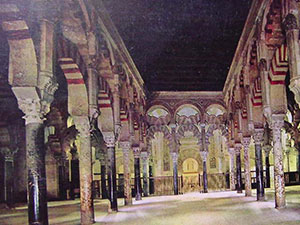
Minaret at Samarra, 847 AD
The first Abbasid caliphs
In 750 AD, the Abbasid caliphs murdered all of the surviving Umayyad men but one.
Who were the Umayyads?
All our medieval Islam articles
Turn away from the Mediterranean
They took over ruling the Islamic Empire. The Abbasids were less interested in the Mediterranean coast than the Umayyads had been. So the Abbasids concentrated more on the plains of Iraq and Iran, and less on the coast: Israel, Syria, and Lebanon, and Egypt.
Fight with China in Central Asia
But towards the east, the Abbasids quickly came up against the Tang Dynasty Chinese. The Chinese were also expanding their empire at this time. The Arabs won a great battle against the Chinese in 751, near Samarkand in Central Asia, but the border between the Islamic world and China stayed about the same from then on.
More about Tang Dynasty China
Abbasid capital in Baghdad
In 762 AD the Abbasids moved their capital east from Damascus in Syria. Their new capital was the brand-new city of Baghdad (the h is silent) in Iraq. (Baghdad is still the capital of Iraq today). This shift is another example of the West Asian conflict between an orientation toward the land and an orientation toward the sea.
The coast and the plains
Baghdad was soon a big international city, where people spoke Aramaic, Arabic, and Persian. Many different groups of people lived there: Arabs, Persians, Jews, and Greeks.
Jews in the Islamic Empire
Baghdad’s people worshipped many different gods. There were Christians, Jews, Buddhists, and Zoroastrians, in addition to the Islamic majority. By the 800s Baghdad probably had nearly half a million people (that is half as big as Rome during the Roman Empire), and was the largest city in the world outside of China.
Christians in the Islamic Empire
Who were the Zoroastrians?
What is Buddhism?
What about the Mazdakites?

Cordoba mosque, Spain
Umayyad Caliphate in Spain
But remember that one surviving Umayyad man? He fled from Damascus around the Mediterranean to Spain. When he got to Spain, he founded the Umayyad Caliphate of Spain. He and his successors ruled Spain for many years.
More about Islamic Spain
The mosque in Cordoba
The Abbasids in Europe
The Abbasids ruled all of West Asia and North Africa from 750 AD . About 830, they conquered Sicily and southern Italy, too. They held on to most of the Mediterranean Sea until about 1000, when they began to weaken. First North Africa broke away and formed independent kingdoms under the Fatimids.
Italy in the High Middle Ages
The Fatimids in Egypt
The Abbasids lose power
Then gradually the governors of each province – like the Samanids – began to act more and more independently, and the Turkish generals of the armies became less and less under the control of the Caliphs. The Seljuk generals began to take over, and by 1055 the Abbasid caliphs didn’t really have any power anymore.
Who were the Samanids?
More about the Seljuks
The successes of the First Crusade in 1096 in taking over Jerusalem and much of Israel and Lebanon happened mainly because the Abbasids were getting less and less powerful.
The First Crusade
The Normans in Italy
Then about 1100 AD, the Normans conquered Italy and Sicily. For a long time, there was still an Abbasid caliph, but nobody paid any attention to what he wanted. Other people – the Mamluks, the Seljuks, the Ayyubids – had the real power.
Who were the Mamluks?
Saladin and the Ayyubids
In 1258 AD the Abbasid dynasty ended when an invading Mongol army rolled the last Abbasid caliph in a carpet and kicked him to death – to avoid spilling his sacred blood.
Learn by doing: build the Samarra minaret out of sand
Go on to the Seljuks
Bibliography and further reading about the Abbasids:
or this article in the Encyclopedia Britannica